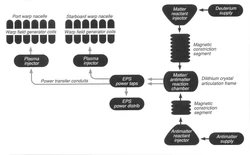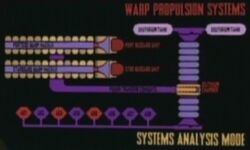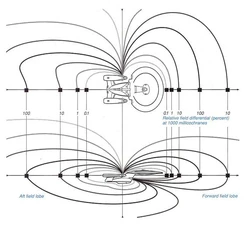A warp engine is the primary faster-than-light propulsion system aboard all known starships within the Milky Way Galaxy.
Physics[]
While the laws of relativity prevent an object from moving through space at faster than light speed, an object can move with space at faster than light speed if space itself is moving. Warp drive technology works on this principle.
Because gravity and electromagnetism are simply different manifestations of a single universal force, gravitational forces can be manipulated through the application of precisely generated and controlled electromagnetic forces. Electromagnetic forces, therefore, can be used to alter and control the geometry of space, as gravity is the curvature of spacetime. The controlled electromagnetic fields generated by a warp drive engine on a spacecraft manipulate gravity in order to distort the spacetime immediately around the spacecraft in a manner that causes that specific area of spacetime to be propelled to velocities that exceed the speed of light with the spacecraft remaining inside this accelerated spacetime.
Travel at faster than light speed is possible in this fashion because the spacecraft is, strictly speaking, stationary while spacetime itself is traveling. Similar to a surfboard being carried by a wave of water, the spacecraft is merely being carried by a distortion of spacetime.
System Mechanics & Basics[]
The WPS is comprised of three major components:
- Matter/Antimatter Reaction Assembly (M/ARA)
- Power Transfer Conduits
- Warp Engine Nacelles - the best part about this setup is that not only does it power the warp engines, but also all primary systems allowing the Warp Core to act as ships Main power core.

The basic mechanics of a warp core are no different to a 20th century automotive internal combustion engine. The matter/antimatter reaction assembly is made up of 4 secondary systems:
- Reactant Injectors
- Magnetic Constriction Segments (MCS)
- Matter/Antimatter Reaction Chamber (M/ARC)
- Power Transfer Conduits
There are 2 sets of reactant injectors, these are similar to a cars fuel injectors. One is the Matter Reactant Injector (MRI). The other is the Antimatter Reactant Injector (ARI). The MRI takes in Sub-Zero cold Deuterium from the Primary Deuterium Tankage (PDT) and then heats it up to a gas. The MRI itself is constructed of Dispersion-Strengthened Woznium Carbmolybdenide. In dealing with antimatter many precautions must be taken because if some were to mix with normal matter outside of the chamber, there would be an explosion that would make the atomic bomb look like a sparkler. The MRI and ARI are basically the same except that the ARI uses Antihydrogen and dealt with in smaller amounts. Also, the ARI uses magnetic fuel paths to control the antihydrogen.
The reactant injectors each take up a deck by themselves. Connected to the two hooks in the middle are the MCS. The two injectors are slightly different as you can see.
The Magnetic Constriction Segments (MCS) have the most important job. Their job is to keep the M/ARC at the perfect conditions for optimum power output and to avoid a core breach. A segment is made of tension frame members, a toroidal pressure vessel wall, and magnetic constrictor coils. The pressure vessels are made of alternating layers of vapor-deposited carbonitic ferracite and transparent aluminum borosilicate. The pressure vessels do like they say, they control the pressure of the M/ARC. The magnetic constrictor coils are made of cobalt-lanthanide-boronite with 36 other elements to keep from spilling. The coils propel the matter and antimatter into the chamber so that they collide right in the middle of the chamber, this where the combustion begins. The frame members are the first things that help keep the reactants together. They are bonded together to form one complete structure. The frame members also have conduits for structural integrity fields. The outermost layer of the MCS is transparent and allows the crewmembers to insure that everything is running smoothly. To the right is a picture of a MCS.
Then there's the Matter/Antimatter Reaction Chamber (M/ARC) which is similar to a cars fuel ignition chamber. This part is made up two bell-shaped wells. The center band of this assembly holds the structure for the Dilithium Crystal Articulation Frame (DCAF). The most important part of the M/ARC is Dilithium. This legendary substance is the only thing known to 24th century science that will NOT react with Antihydrogen.
The final part of the engine system is the Power Transfer Conduits (PTC). These components do exactly what they sound like they would do. The PTC is very much like the constrictor segments, in that they use magnetic field to control a plasma stream and force it towards the nacelles. This is the systems Rack and piston section.
Warp Field Nacelles[]

Basic Warp Nacelle Schematic

Warp field diagram
The Nacelle itself is an outboard engine housing structure that both helps and creates a Warp Field. Due to massively dangerous levels of radiation generated by the Nacelles themselves they are kept separately from the ships main hull with the use of large pylons in which sections of the Power Transfer Conduits are housed.
Most Warp Nacelles are equipped with a Bussard Particle Ramscoop which is located at the fore end it collects several forms of common and rare particles, however it mainly gathers Hydrogen (to convert into Antihydrogen).The process in which the Nacelles work is after the Matter/Antimatter is converted into Electro or Warp Plasma and forced through the Power Transfer Conduits into the Electro Plasma System or (EPS) Conduits. The Electro-plasma is then funneled through a series of plasma injectors and into a series of Internal Warp Field Coils (Warp Field Generators).
These Coils are composed of Verterium Cortenide creating a "Warp Field". The field itself is basically a Sub-Space displacement field which warps the very fabric of space and allows a ship to "Ride" along a spacial distortion. However this can be explained in much easier terms. Imagine holding a bar of wet soap, as you squeeze the soap harder and harder the faster it is likely to shoot out of your hands. This is the basic principal of Warp Drive as the nacelles eject more plasma into the Warp Coils the tighter the external Subspace Bubble squeezes around the ship allowing it to move faster through space.
External Links[]
- Warp drive article at Memory Alpha, the canon Star Trek wiki.
- Warp drive article at Memory Beta, the non-canon Star Trek wiki.
- Warp drive article at Star Trek Expanded Universe.